* (restored)

Quote
“David Bohm said, ‘…according to today’s laws of physics, the bumble should not be able to fly…the shape of its wings, their velocity of operation, and their size, compared to the bumble bee’s body, make no sense…it’s a miracle, it’s comical, and it cannot be denied.’ …This is why I am an artist.” — Tom Friedman
Elsewhere
A visit with Tom Friedman
Tom Friedman @ Gagosian Gallery
Tom Friedman @ Ceysson Gallery
Tom Friedman, the book (Phaidon Press)
The Obsessive Art of Tom Friedman
Tom Friedman interviewed by John Miller
Tom Friedman in Tokyo
Dan Cameron on Tom Friedman
About
‘Tom Friedman’s studio is a sensory deprivation chamber. A small shed about 50 feet from his home in the western Massachusetts countryside, it is windowless and featureless, immaculately tidy, completely empty and painted white.He has compared it to the blindingly white prison cell in the science fiction film THX 1138 (1970).
Friedman works in this environment to get a better view of the shape of his own thoughts. Knotted, looping, self-generating, endlessly expanding and dissipating, these are the raw materials with which he makes his sculptures and drawings. The end result, the object, whether it’s a frail thread of chewing gum stretched between ceiling and floor or a hyper-real dragonfly assembled from hair and clay, is just a diagram and a trace of the stuff he’s scraped from the inside of his head.
Friedman’s works operate as closed, repetitive systems which run until they break down; at this point an eerie sense of the unreal begins to seep from the split gaskets. ‘The idea of pulling things further and further apart is interesting’, he has said. ‘Stretching a piece of gum is an analogy for this idea: as you stretch the gum the connecting thread becomes thinner and thinner. I reached a point where the idea of fantasy started to filter in, because when the connection between things becomes so slight, they are not read as a cohesive whole.’ — Adam McEwen, Frieze (continued)
Media
Public Art Fund Talks at The New School: Tom Friedman
Tom Friedman at Luhring Augustine, NYC (February 2012)
Tom Friedman at Stephen Friedman Gallery, 2012
Tom Friedman – installation at Magasin 3
Tom Friedman remembers Hudson
Serious Playboys
Tom Friedman in Conversation with John Waters
from Parkett
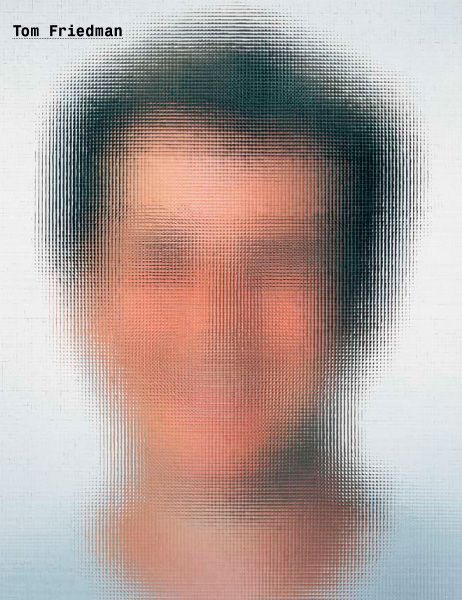
John Waters: A friend who doesn’t follow the art world saw your book and said, “You have to have a real faith in contemporary art to look at Tom Friedman’s work.” Do you agree?
Tom Friedman: It seems like people can enter my work on different levels. People who don’t know a lot about contemporary art seem to enter it because of the type of things I do with materials…
JW: Oh I agree! It is good that you have to have faith in the art world to look at someone’s work. Then at least you’re going to really look at it. Your work is self-assured in a humble but strong way, but in some of the pieces you demand faith. When you say, for example, that you stared at a piece of paper for a thousand hours, you are demanding faith from the viewer, don’t you think?
TF: Yeah, I guess faith in my credibility.
JW: What is so amazing about your work is that even the most unsophisticated art person is not pissed off because before they can say “Oh, my kid can do that,” the words get stuck in their throat because their kids most definitely could not do that.
TF: Because I seem to put myself through a sort of torture, people feel that if I’m going to put myself through that, they might as well give a little of themselves.
JW: But is it torture or magic? I mean you were a magician as a kid—I’m sure critics make too much of that—but were you for real?
TF: My brother and I used to put on shows for kids. We were called Ali & Oop. I was Oop.
JW: I was a puppeteer, so we were on the same circuit; kids birthday parties.
TF: (laughter)
JW: All art shows are magic in a way, aren’t they?
TF: Yeah.
JW: And I wonder if talking about it gives away the trick in a way, even what we’re doing now. Real magicians will never tell you how they do the trick.
TF: I try to be incredibly obvious and straightforward, but this sort of conceals itself again. I’m trying to reveal the secret. It’s like a secret that everyone knows.
JW: When you were young did art ever surprise or shock you?
TF: Not really. I didn’t look at art that much. I got started making things as a way of trying to understand the world around me, and it still is that way for me. It becomes a vehicle for my understanding, so each piece represents some kind of discovery that I make about the world.
JW: But you can see how some of your most obsessional pieces are sometimes shocking to others.
TF: I can see that.
JW: Is patience to you a virtue or a compulsion?
TF: I guess both.
JW: In your work certainly, patience has to be one of your tools, as much as the material, isn’t it?
TF: I think my patience comes from faith and also a need to pursue an idea. I have to see it through and make it physical to complete my understanding of it.
JW: Do you ever change your technical approach mid-way through?
TF: Well, yes. I was working on a piece with pins in a sheet. I started it off by doing it one at a time — which became absurdly monotonous. Then I tried to figure out ways of doing it faster. I constructed this screen so the pins would fall through with their heads all in the same way. Then I had to work out a way to orient the pins, so I could pull out a clump and stick them in. I rigged up a device that consisted of a block and a magnet so I could then stick in a whole bunch at one time.
JW: So in a way you came up with a primitive form of mass production.
TF: Right. I do look for ways to make things easier. My work tends towards this very repetitive labor process for some reason, yet it is not really about that.
JW: It is and it isn’t. When I look at one of your pieces, I wonder how could such a thing be done, and buried in that, I think, is a whole hierarchy of labor processes. In most cases, the disappearance of the hand makes something more attractive — unless you flip back into an Arts and Crafts esthetic which values something for its archaic qualities.
TF: That’s something you’ve mentioned quite a few times.
JW: That’s because the machine qualifies what it is to do something by hand in this day and age. It plays out in a lot of different ways. Warhol said, “I want to be a machine,” but that was very romantic, a romanticization of the mechanical.
TF: I always interpreted that statement as striving to reveal the human element by denying it.
JW: By falling short of perfection?
TF: Yes. Striving for that machineness might show the residue of what is human, and that always interested me: the absurdity of wanting to be a machine.
JW: David Robbins has referred to you as “the Manzoni of the ’90s.” Manzoni’s canned shit and his pedestal for the earth — like a lot of his other work — both have a lot to do with how one orients oneself. I think of your inverted map: looking at the world from the North Pole. Then, of course, there’s your speck of shit versus his can.
TF: What I know of his work seems to emanate from thoughts about his self in relation to … the world, I guess.
JW: Yeah, but also in relation to the readymade. His pedestal claims the earth as a readymade and the canned shit claims the results of an involuntary, physiological process. In your work, everything you start out with remains the same. The spaghetti is still spaghetti, the pins are still pins, the map is still a map …
TF: I try to establish a logical connection between what a material is, how it is transformed and what it becomes. It retains its identity, but as symbolic material. It becomes symbolic because you are looking at it.
JW: Does the scale and fragility of your work ever create storage or transportation problems? Take your bubblegum piece, for instance.
TF: The bubblegum just goes in a box and that’s it.
JW: The one that stretches from floor to ceiling?
TF: Oh, that one. I thought you were talking about the bubblegum. [laughter]. Yes, a very long box!
JW: So you just make it again every time.
TF: Well, I’ve only shown it twice. Once at Feature, and then once in a show curated by Ivan Moscowitz. And he installed it.
JW: Oh really? He must have had a lot of patience.
TF: I had very specific instructions. They had to be incredibly detailed. Well, not incredibly detailed but … you know, second by second. The first thing was that I had to figure out a way of making it more predictable. I found this stuff called Friendly Plastic and I mixed a small amount of that into the bubblegum. It made the mixture slightly harder when it was stretched, and so it wouldn’t sag — which is something I was concerned about. But the Friendly Plastic actually complicated the installation because you have to boil it, then you have to wait exactly the right amount of time for it to cool off before you stick it on the ceiling and stretch it to the floor. So when it came down to shipping, it all just went into a small box, a slide box. Other things just get thrown away, like the piece I did with laundry detergent. That just got swept up. The toothpaste — I did a piece with toothpaste on a wall — that just gets scraped off and thrown away.
JW: So a collector ends up purchasing instructions?
TF: Yes — and a lifetime supply of bubblegum. [laughter].
Work
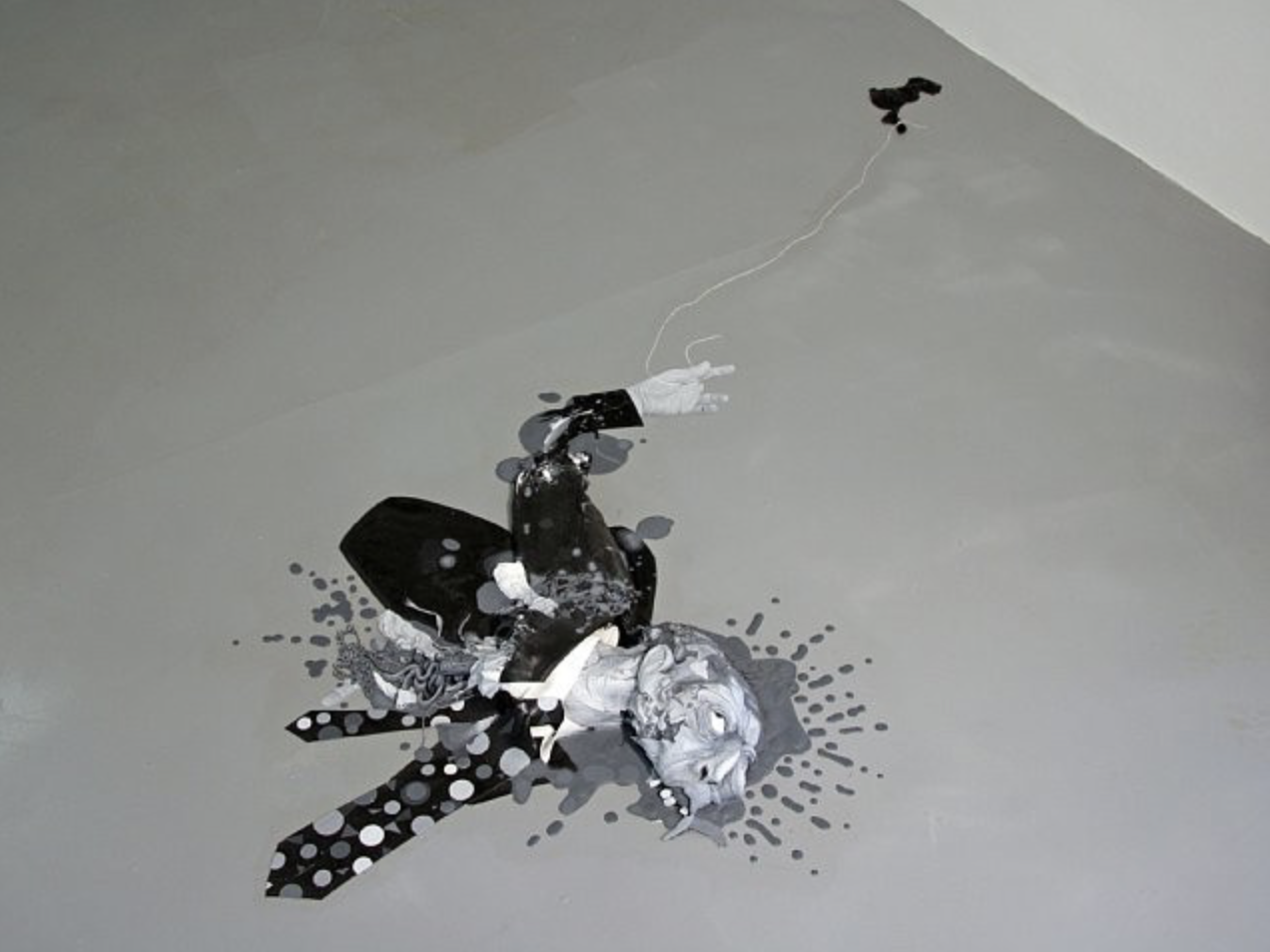
blackandwhitepaintfig. (2006)
black and white paint on concrete floor
4 x 31 x 75-1/2 inches (10.2 x 78.7 x 191.8 cm)
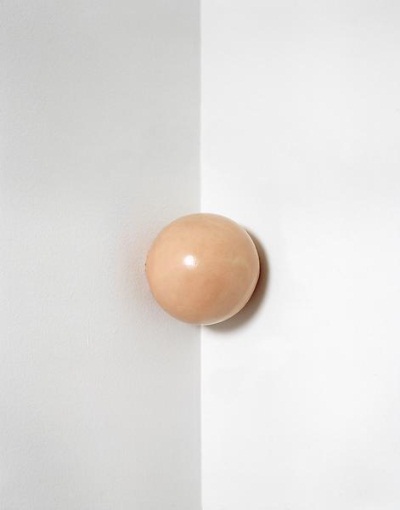
Untitled (1990)
approximately 1,500 pieces of chewed bubble gum molded into a sphere and displayed at head height in a corner, hanging by its own stickiness.
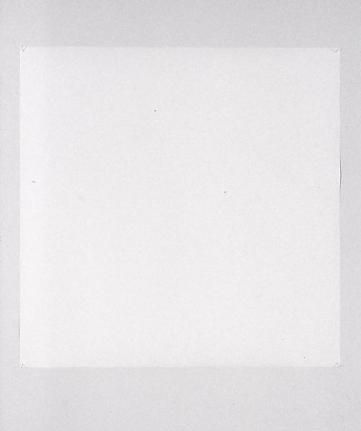
1000 Hours of Staring (1992-97)
a blank piece of paper stared at by the artist for 1,000 hours
32 ½ x 32 ½ inches
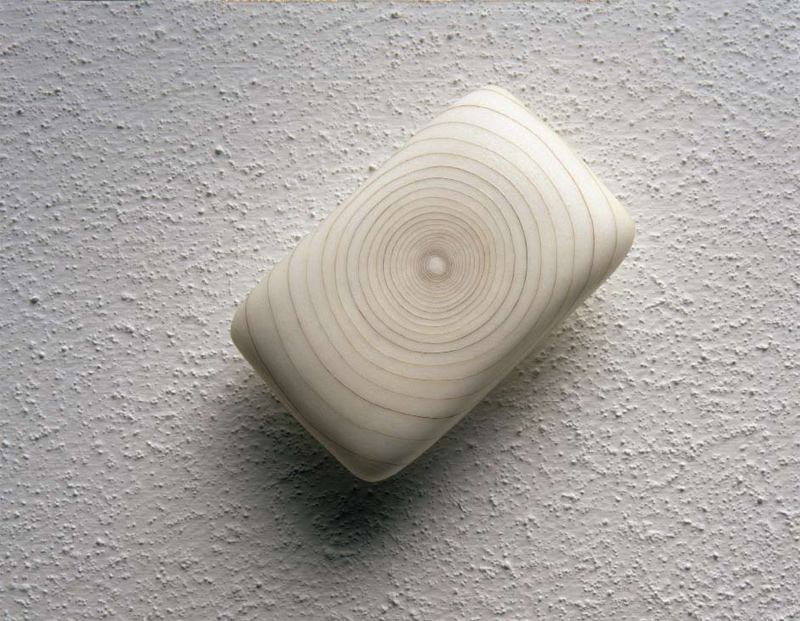
Untitled (1990)
a partially used bar of soap inlaid with a spiral of the artist’s pubic hair
3 x 4 x 1½ in. (7.6 x 10.1 x 3.8 cm.)
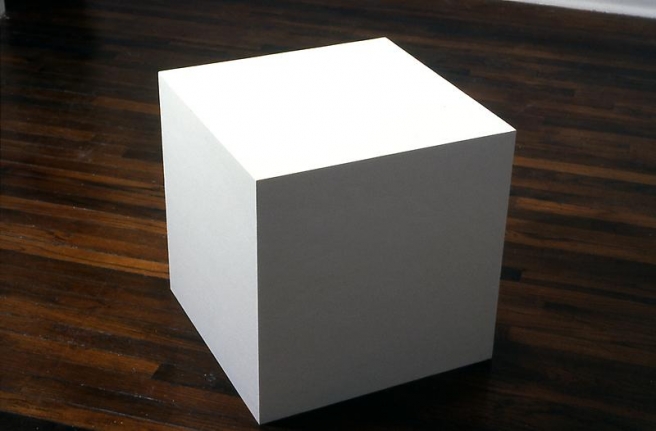

Untitled (1992)
a sphere of the artist’s feces ½ mm in diameter centered on a cubed pedestal
Pedestal: 20 x 20 x 20 inches
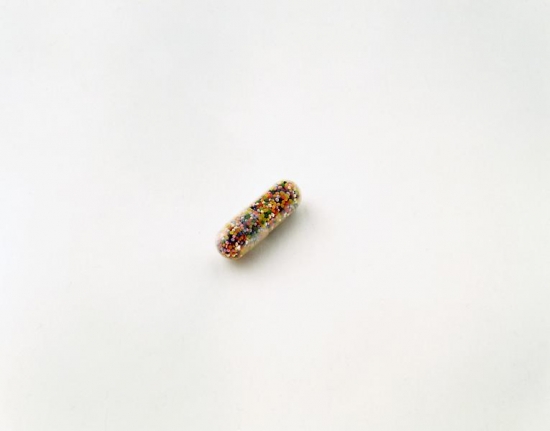
Untitled (1995)
a gelatin pill capsule filled with tiny spheres of Play-Doh
¼ x ¾ x ¼ inches
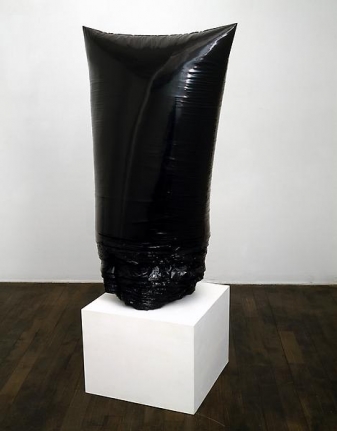
Untitled, 1992
approximately 3,000 garbage bags layered one inside the other until no more could be added
63 x 28 x 20 inches
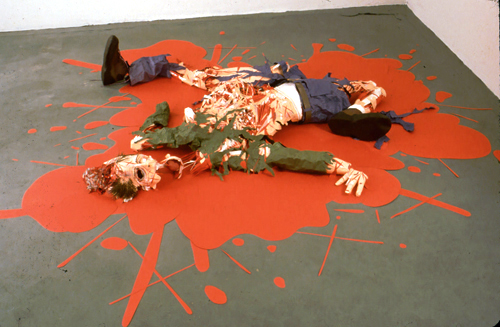
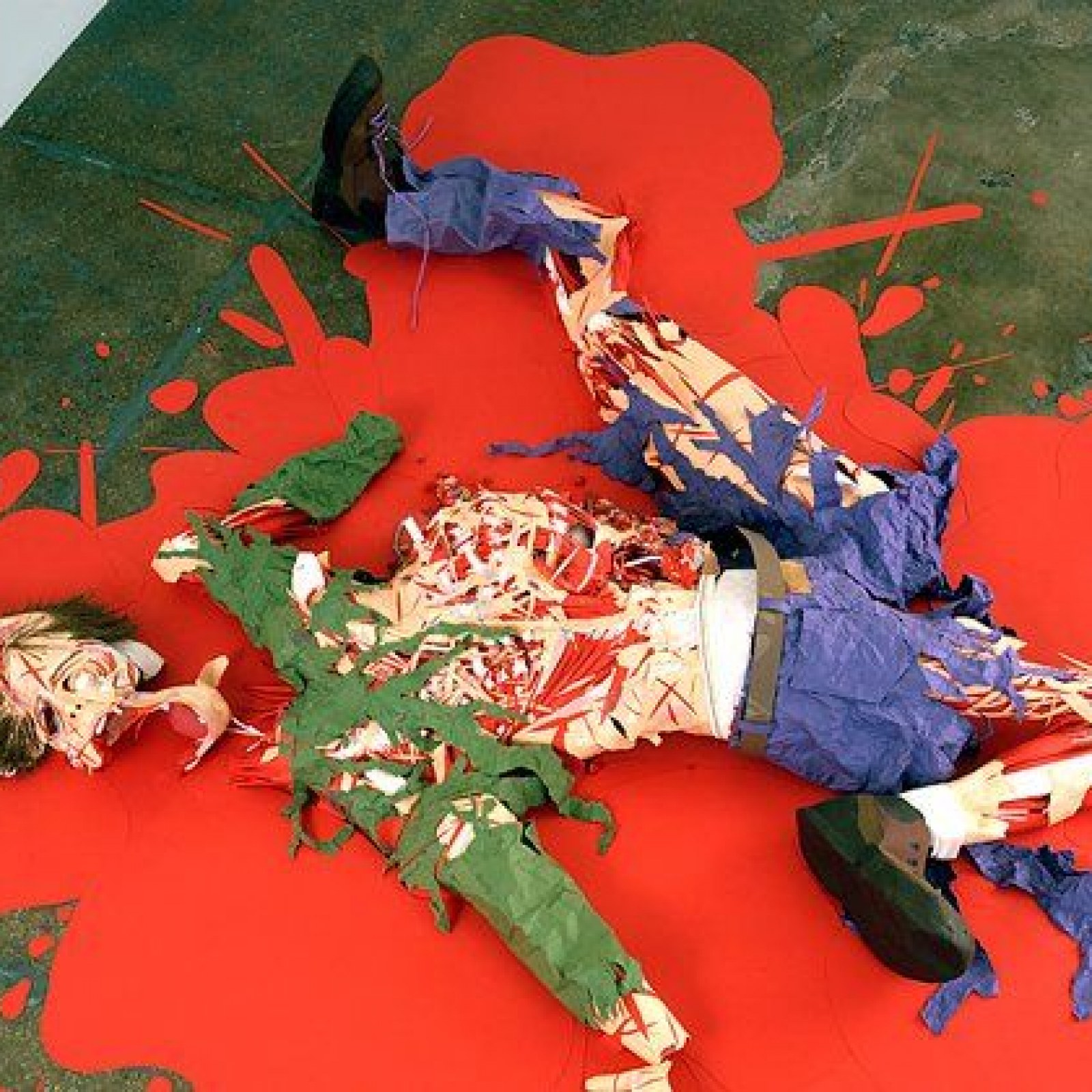
Untitled (2000)
construction paper
12 x 114 x 120 inches
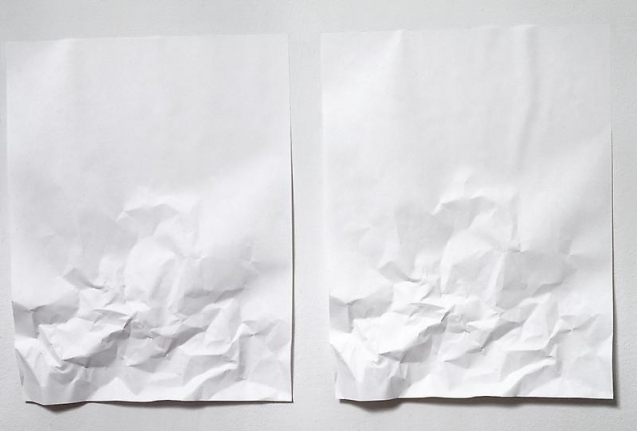
Untitled (1990)
two identically wrinkled sheets of paper
2 parts, each: 11 x 8 ½ inches
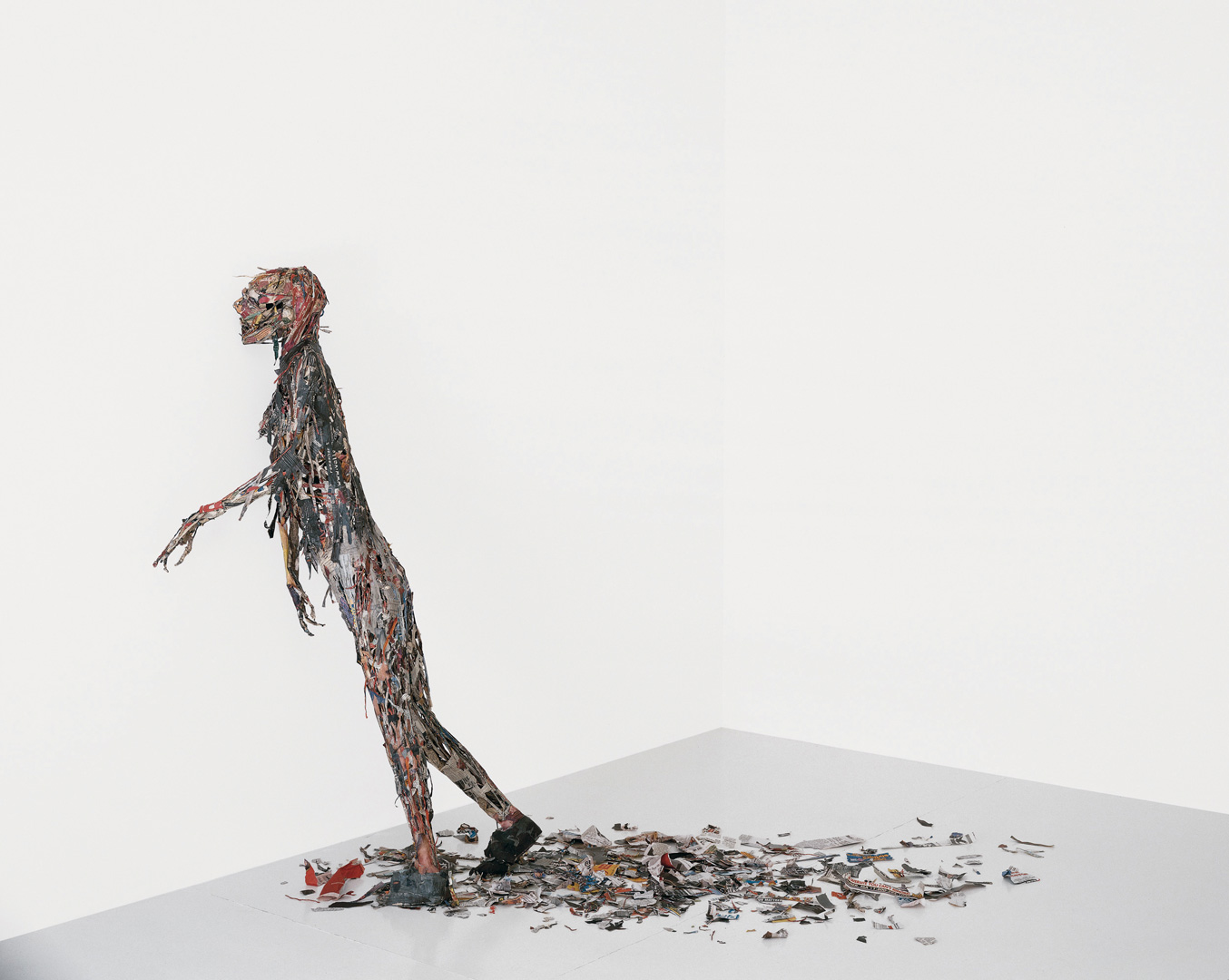
Zombie (2008)
newspaper and wheat paste
67 x 28 x 96 in. (170.18 x 71.12 x 243.84 cm)

Untitled, (1999)
36 dollar bills combined to make one large dollar bill
14 x 35 1/4 inches
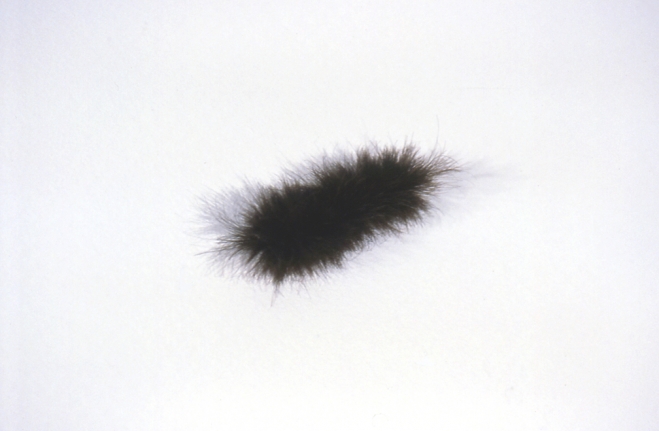
Untitled (Hair) (2000)
2 15/16 x 1/2 x 1/2 inches
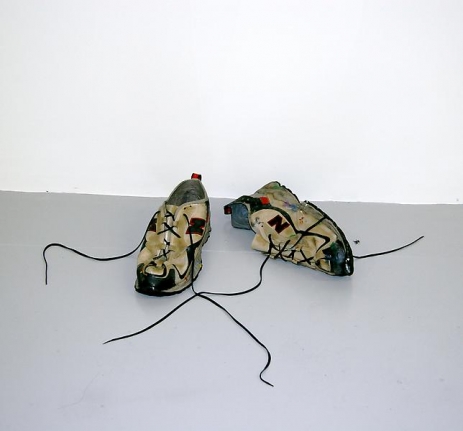
Untitled (2005)
a replica of the artist’s shoes made entirely out of paint
Each: 4 x 11 ¼ x 4 ¾ inches
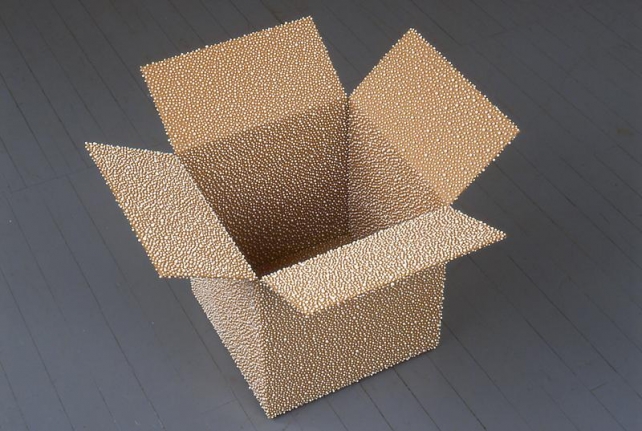
Untitled (2002)
a cardboard box covered with Styrofoam balls
23 ¾ x 27 x 27 inches

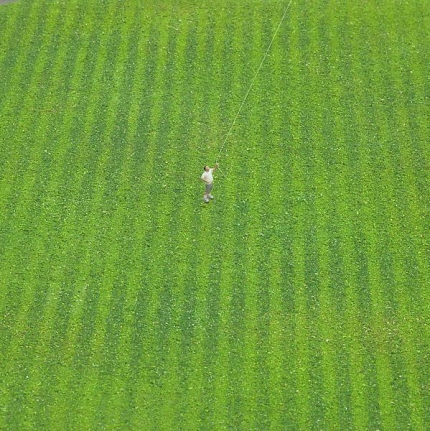
Untitled (kite) (2012)
wood, paint and monofilament
Diameter of base: 41 1/2 inches
Figure: 1 1/8 x 3/8 inches
String: Dimension varies
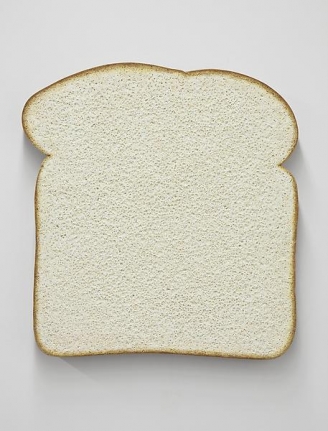
Untitled (White Bread) (2013)
styrofoam and paint
36 x 36 x 3 7/8 inches
(91.44 x 91.44 x 9.84 cm)
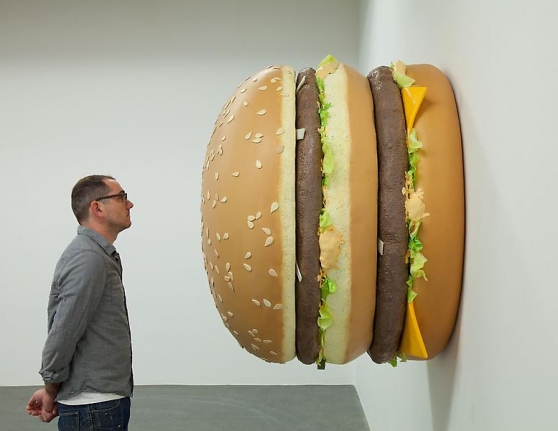

Big Big Mac (2013)
styrofoam and paint
38 1/2 X 50 inches
(97.79 X 127 cm)
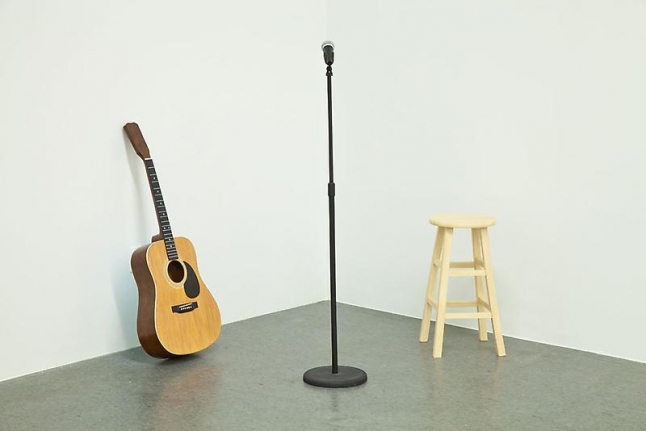
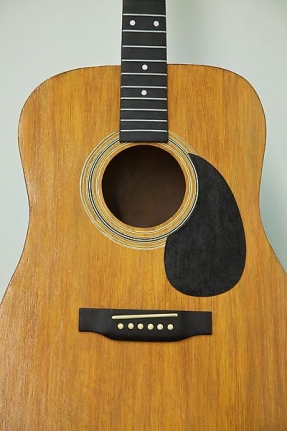
Moot (2014)
paint and styrofoam
Guitar: 41 3/8 x 15 5/8 x 4 3/4 inches
Mic: 54 1/2 x 10 1/2 x 10 1/4 inches
Stool: 23 1/4 x 12 1/4 x 12 1/4 inches
REAM (2006)
a 500-page flipbook made in 2006

Witch (2008)
paper
51 x 39 inches (129.5 x 99.1 cm)
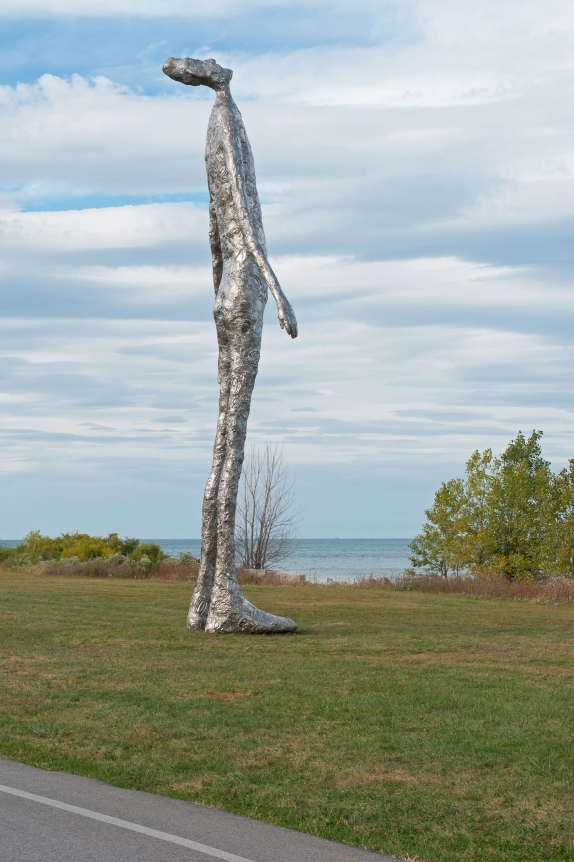
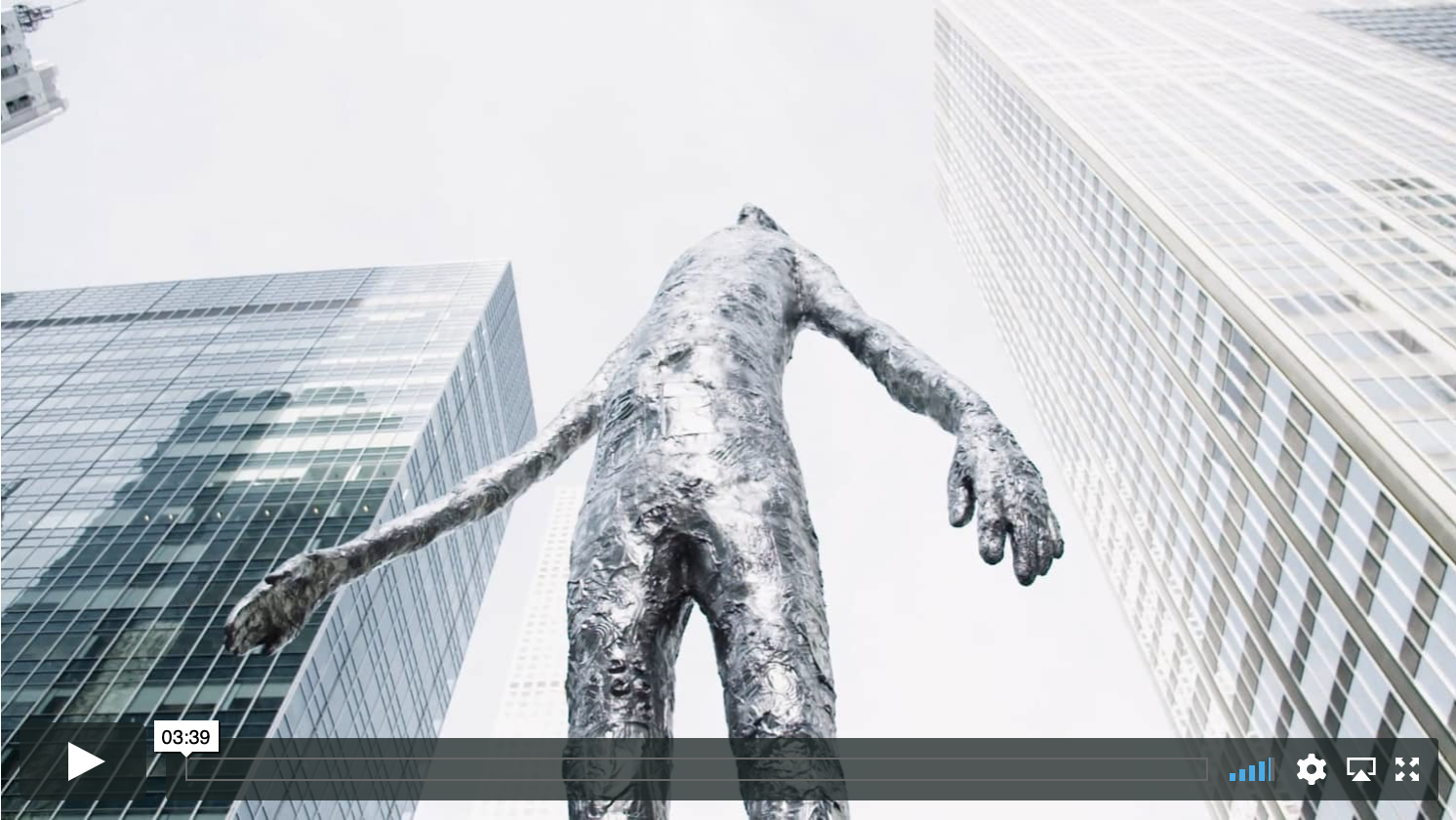
Installation video — watch here
Looking Up (2015)
stainless steel
390 x 130 x 90 inches (990.6 x 330.2 x 228.6 cm)
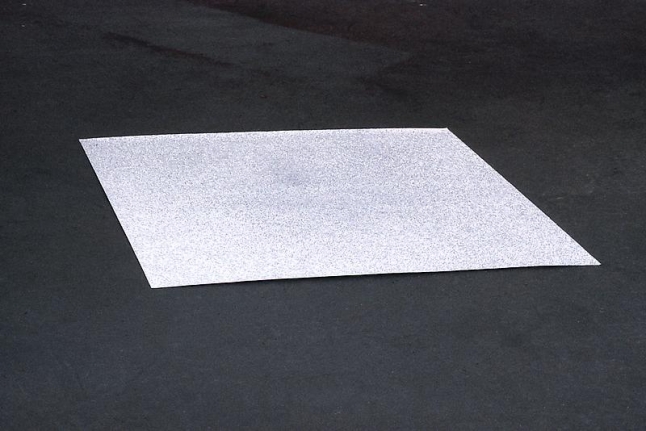
Everything (1995)
all of the words in an English language dictionary written on a piece of paper
36 x 36 inches
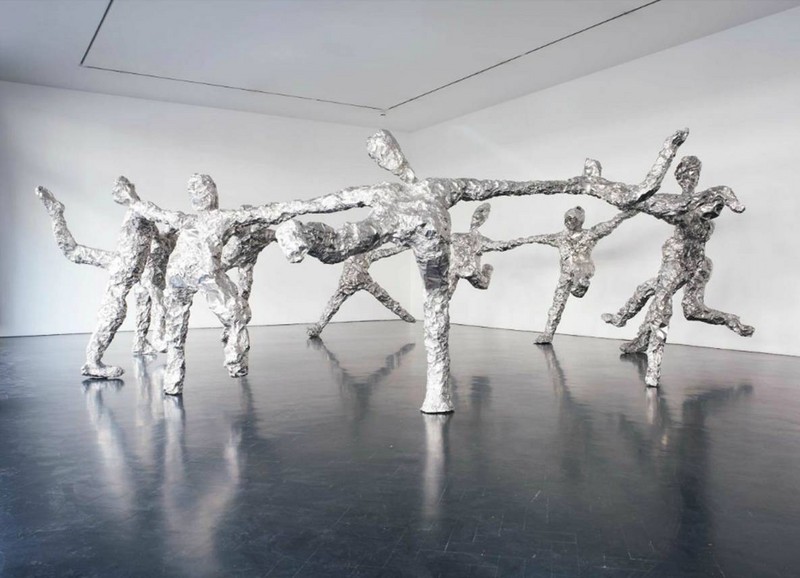
Circle Dance (2010)
a circle of eleven life-sized dancing figures, cast in a highly polished stainless steel
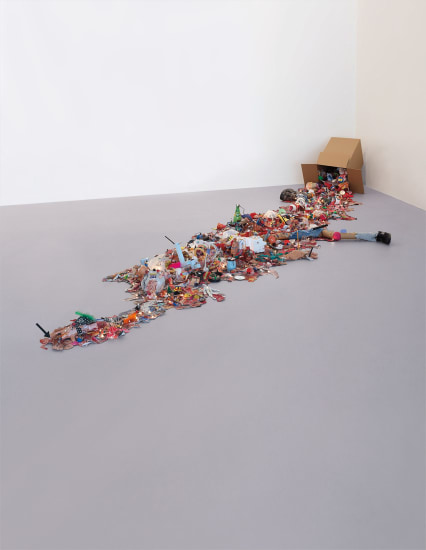
Inside Out (1991-2006)
cardboard box, christmas lights, styrofoam and various media from the artist’s studio
26 1/4 x 186 x 55 in. (66.7 x 472.4 x 139.7 cm)

Untitled (1989)
“painting” using Crest Tartar Control Gel Toothpaste
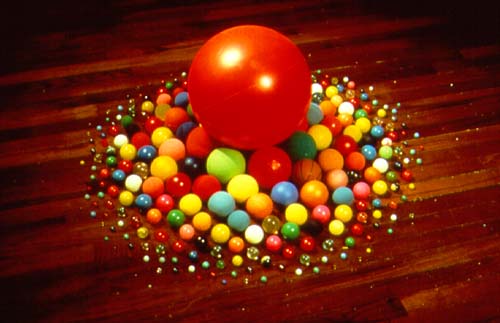
Hot balls (1992)
a collection of differently sized and coloured balls stolen by the artist from various stores over a period of six months
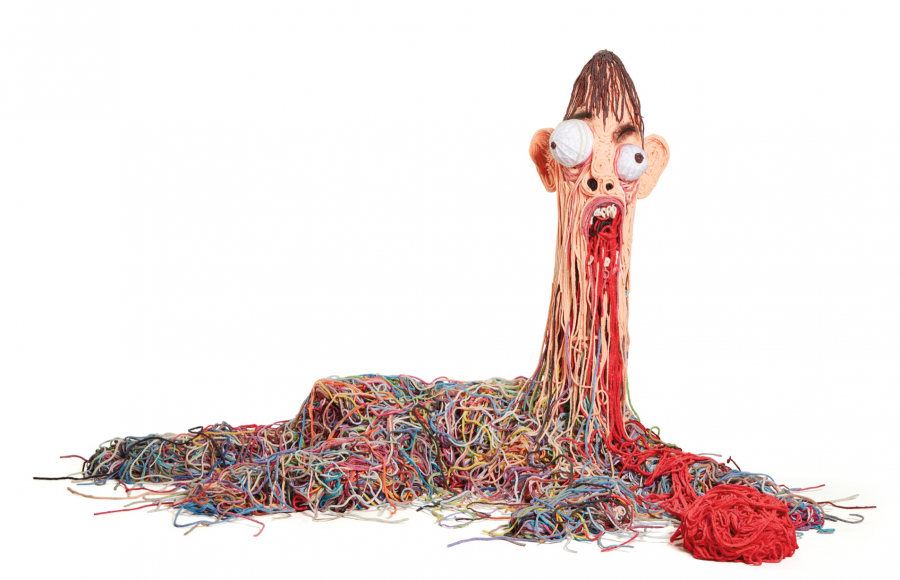
Yarn Dog (2006)
yarn and wheat paste
23 x 44 1/2 x 24 1/4 inches
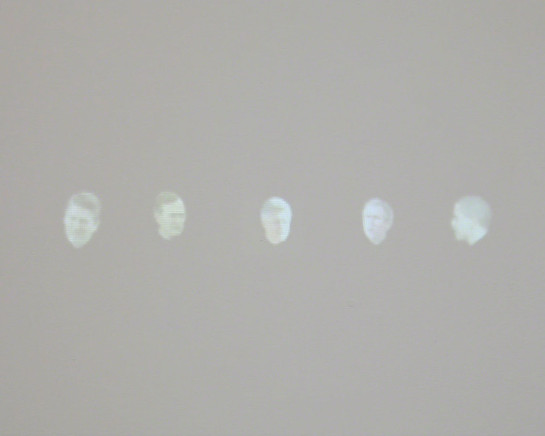
Dotted Line (2017)
video projection, silent
Dimensions variable
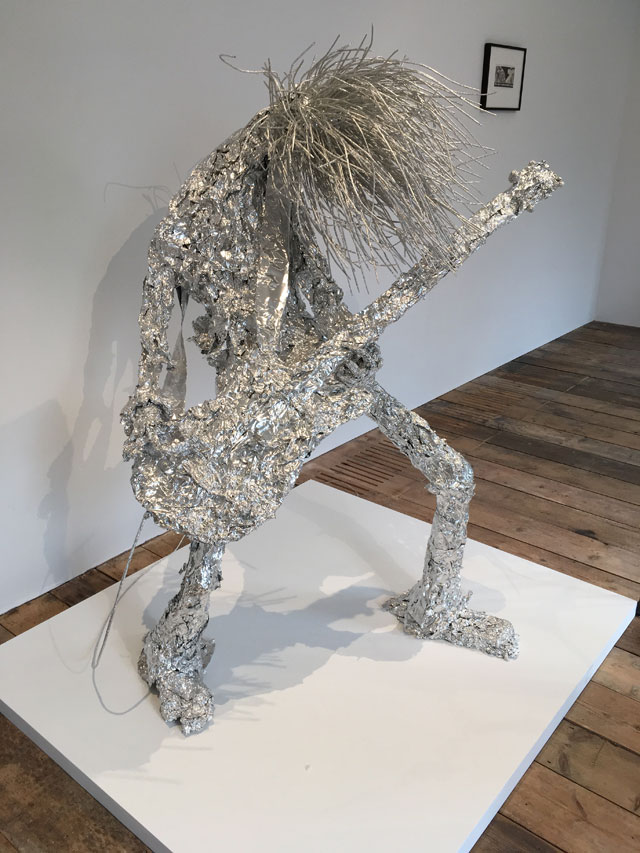
Untitled (Foil Guitarist) (2004)
aluminum and wood with colored pencil on paper Tootsie Pop wrapper
70 x 48 x 30 in
*
p.s. Hey. ** David Ehrenstein, You were a wild young’un! Newman’s vocal on ‘Gone Dead Train’ is nuts. ** Bill, Yeah, but, and I’m assuming mind you, that in the master/slave dynamic, annoying could be a solid come on, i.e. ‘you’re asking for it!’? Just a guess. Yum, the Bill pears. Right, it’s, like, raining and snowing all over the Californian place, I read. That’s a lot of quirky, sir. Quirkiness is tough to pull off and not just, well, annoy, ha ha, as I’m sure you know, but I know you will. Pull it off. ** Sypha, Sorry about asking you to think something up. I was a blank regarding my personal delight yesterday. Ooh, but now you’ve intrigued me. So perfect! Yes, if the postcode of the address of mine you have is 75008, it’s the same/right one. Thanks, James. ** Signed Out, Hi. Oops, I’m sorry. No, it wasn’t, like, a value judgement on their stuff. They just really annoyed me personally. They and I were not a good match. But I think a lot of more people liked/like them than consider them nails on a chalkboard. So you can just consider me unenlightened on the Oingo Boingo front, and I’ll accept that. But, err, yeah, I don’t like the Grateful Dead. Well, I do like their first three albums, but, after that, definitely not my thing. Anyway, ultimately it’s all about feeds you, you know? If it excites you, it’s good. That’s all that matters, I think. ** _Black_Acrylic, Ha ha. I hope he finds a master who encourages his art. And good luck to him with that. Well, I suppose a hung parliament is better than nothing. Still hoping against hope that Corbyn can squeak it out, but … yeah. ** Steve Erickson, I think horny guys using the ‘TV producer’ come-on probably go more for the escorts than the slaves, but what do I know? Wow, a top 10 films for the whole decade? That seems awfully, awfully tight. I don’t think I could do that. But curious to read what you select. Hope your night of intended film building paid off. ** Misanthrope, Yeah, give her my very best, my respect, and all of France’s too if I may be so bold. Sounds nice: the garden light walk thing. Falling out has its virtues. God knows. ** sleepyj, Hey, sleepy. Where do you stay when you’re in LA? Area, I mean. Plans on how to max the place out? ** Right. I decided to restore today’s gallery show featuring the delightful stylings of one of my favorite contemporary artists, Mr. Tom Friedman. Try to get into it. Thank you. See you tomorrow.




 Now available in North America
Now available in North America 
Friedman manages to wed the ordinary to the obscure in unique ways. I love the torn-apart dolls.
Looked at “The Irishman” again yesterday and like it even more. Netflix sent us (critics) an enormous book of the film that gorgeous illustrates its key moments. It goes for 200 but I’m not selling. I AM however selling a whole lot of other stuff.
Good to see this Friedman gallery again, Dennis. That construction paper suicide guy blew my mind when I first saw it years ago, and continues to do so. And that soap with the pubic hair! Geez.
The quirky piece for the quirky space is going slowly, due to some annoying technical roadblocks. It’s good to be back in the piece-hacking headspace, but I need something presentable for Sunday, eek.
Alright, maybe I’ll consider checking out The Irishman sometime, 3.5 hours and all. But after the gig.
Bill
I had the Phaidon book of Tom Friedman’s work, with an essay by a certain DC person, and I always found that showing it to folk from a non-art background got a really great response. There’s a child-like wonder there that is very much infectious.
Dennis, A restored Galerie is always better than no Galerie. Looking Up is awesome.
I’ve been doing better with my falling out. Getting about 7 a night, give or take a little. I try. I do feel better.
It was fun, that garden lights thing. Well, it was new to me, and it was fun to watch the kids run around and point things out to me. My friend DR has two pugs, so I pointed out a pug to all of them. Little Hank goes, “No, Mr. George, that’s a turtle.” (It actually was a turtle, I was just teasing DR.) Kids can be really funny, especially when they talk down to me.
Oh, and I forgot this part. So you go back after you’re finished to the big museum or whatever it is. It’s an art gallery with local art. A couple pieces weren’t bad at all. They had these three hillbillies playing Christmas songs. Two women, one on a guitar, the other on a banjo, and a man who was on the bass fiddle and wearing the ugliest Christmas sweater ever. They weren’t bad. They were at least proficient -pretty damn proficient, actually- when it came to playing. I don’t know, I just found it all funny. But nice.
I wound up wasting a lot of time videos on Vimeo and YouTube last night and digging through lots of prank videos by obnoxious bros which I thought might have some worthwhile images, but now the film will segue from a British documentary about Xanax dealers to Canadian astronaut Chris Hadfield to a man swimming with orcas!
Wow, memories. I recall installing many of these pieces. and overseeing the photography of them. Tom was always great to work with – never a diva (unlike SOME I could mention!). And I always looked forward to getting in a truck to go pick up his work near Northampton. He really did live in the middle of nowhere. I fantasize about living like that, but I could never do it.